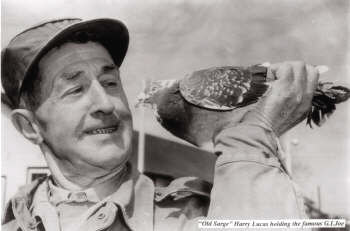Pigeons At War
HOMING PIGEONS THROUGH THE WARS
The history of pigeons as message carriers goes back over 5,000 years. However, none of the various types of pigeons used as the early message carriers were capable of flights much farther than about 40 miles. Nevertheless, by the middle of the twelfth century A.D., a well-organized pigeon post, with post office and postmasters, was being maintained. By 1819, however, the homing pigeon was developed sufficiently to fly 200 miles in a day, and at that time when the principle mode of travel was either by foot or horse, 200 miles was a great distance. For centuries, because Homers were the fastest and most reliable means of communication, leading newspapers of many countries used them to carry news of importance. And, in the early nineteenth century, Homing Pigeons were used in many Belgium cities to bring news of stock exchange quotations from London across the English Channel.

Homing Pigeons were used in antiquity to bring back results of the battles, and in World War I and World War II to carry vital messages. Many books have been written about their heroic feats, in which they were often injured by shell fire during their delivery of vital messages. Their vital messages have saved the lives of many thousands of combatants and civilians. When total radio silence is necessary or where radio communications have been cut-off, they may be the only means of communication. They have provided the balance between victory and defeat in many crucial engagements, unerringly delivering their vital messages even over large bodies of open water, through rain and fog over high mountains and against treacherous winds.
WORLD WARS I AND II

As a result of their heroic efforts, many Homing Pigeons received medals and honors. One United States Homing Pigeon, called “G.I. Joe,” was awarded the Dicken Medal for bravery by the Lord Mayor of London for saving over 100 British soldiers in World War II. “G.I. Joe” is the only bird or animal in the United States to be given this high award.


The racing of Homing Pigeons is made possible by its uncanny ability to find home and by its desire to return to its home as quickly as possible over unfamiliar territory hundreds of miles away. This fantastic ability to “home” in all types of weather conditions is the subject of considerable research. In an age, however, when we have the technological and scientific capability to put men on the moon, we still have been unable to totally unlock the mystery of the homing mechanism.
The American Racing Pigeon Union conducted extensive testing to ensure that the transport of Homing Pigeons did not cause harm to the birds. The hearty Racing Homer is an athlete of great strength and endurance.
Pigeons in War Continued
The following photographs, from the U.S. Army, feature Homing Pigeons that served during wartime. We hope you will find this information enlightening and educational.
Anzio Boy
In 1957, United States Signal Corps transferred two hero pigeons to the National Zoological Park, located in Washington D.C. Anzio Boy and Global Girl completed sixty-one missions between them.
Mocker &Spike
Mocker flew 52 missions and was wounded on his last mission. He was awarded the “Distinguished Service Cross,” as well as the French “Croix De Guerre.” This pigeon, in splendid time, on the morning of September 12, 1918, from the vicinity of Beaumont, France, arrived bearing a message of great importance, which gave the location of certain enemy heavy batteries. This information enabled the American artillery to silence the enemy’s guns within twenty minutes. Mocker is the last WWI hero pigeon to die (1937).
Spike delivered messages between combat squads in the heat of battle. He flew 50 missions without getting injured and earned the Distinguished Service Medal.
Pigeons in War Continued

Pigeons in War Continued
Baskets such as the ones appearing in the photographs were used to carry Homing Pigeons.

Military sometimes utilized portable lofts.
